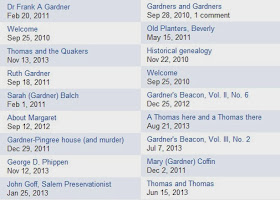Note: See below, for
Table:The Dane Family and Extended Kinship from TEG 19:221.
---
With the turn toward fall that comes with September, all sorts of things loom on the calendar. For one, those festivals related to harvest, such as apple cider (ah,
Johnny Appleseed ought to be remembered every year) and such. Too, Salem rises to public attention, again.
Would not
Thomas (
Beacon Vol. I, No. 4) want us to be interested in anything dealing with his town?
There was more than
Salem Village involved with 1692. For instance, Andover was an important town, too, which we'll get to below.
 |
The Dane Family and Extended Kinship
The Essex Genealogist.
(Online database. AmericanAncestors.org,
New England Historic Genealogical Society,
2011.) |
---
It might be nice to stop, recognize the Associated Daughters of Early American Witches and look at their accepted
ancestor list (not considered complete). The ADEAW list was used for the "
Imagine a meeting" post from 28 Oct 2012 (follow up post on
10 Feb 2013). That first post commented on, and showed examples of, the inter-relationship between ancestral families on one person's tree (it was not a complete listing and was presented only for discussion purposes).
---
Today, while searching on
NEHGS (it's nice to find well-researched papers), I ran across a paper by Marjorie W. Otten (1999 - TEG 19:221) who was writing about the Ingalls/Dane families. Of course, Rev. Francis Dane (see list from 28 Oct 2012) was mentioned.
On looking at the article, I found an interesting little chart in which Marjorie enumerates those in Rev. Francis Dane's extended family who were accused of witchcraft (and, for the most part, imprisoned) during the time of the craze. Now, we know that Rev. Francis Dane was critical of the authorities. From the list, one might get some notion of why this was so. His cohort, Rev. John Wise (another person on the tree), was on the opposition side, too.
From what I've seen, Marjorie has studied, and written a lot, about the events of 1692. So, given her expertise and scholarly way, it was good to see a listing like this. Perhaps, we would learn something if we had this for all of the families who were there (say, think of an exercise to help fill in one's tree - or, get a new respect for those who were tormented).
Not only were families persecuted, so too, their associates and friend would have been deeply troubled.
Aside: Think of the six-degrees analysis associated with
Kevin Bacon to get an idea of the magnitude of relationships that could be collected if transitivity were carried out beyond immediate ones.
---
It's early, but, we'll have to consider the Salem Village theme, again, this year.
Remarks: Modified: 09/21/2021
09/04/2013 -- Again,
the scene is built as follows. Those who came over are from the 10th to 15th generations back (for the most part) for someone alive now. By the time of 1692, lots of the earlier arrivals had passed on. So, that left the
second generation (again, for the most part) as the elders. Now, taking a cohort mix (generational cut) round or about 1692 would give us someone on the current person's tree who would have about three generations living (including the level of their own cohorts). So, we would see siblings/cousins, parents/aunts/uncles, and the greats. In other words, it's a
composite person that is built from that cohort mix (meaning, of course, that being on the tree implies ancestry) for which we can identify relationships blood (including 1/2 blood), in-law, and even friends. What Marjorie's chart does is to take someone who is in the mix and look at extended relationships. Now, consider what we would have if we did that for a large part of the composite mix. Would it not be an interesting view?
10/15/2013 -- The article was about the extended family of Rev. Francis Dane. The image can be updated for other families. Doing one of these would be a interesting exercise, say for a Dane descendant. That is, someone from about three generations ago who is a descendant of Rev. Francis' father, Dr. John.
10/20/2013 -- Added note at top, which is referenced from
Wikipedia article on Francis Dane.
10/30/2013 -- I am in the process of reading Katherine Howe's book,
The Physick Book of Deliverance Dane. Dane, as in being related to
Francis, of course. I wondered if there would be motivating material for a Beacon issue (we did have 1692 as a theme in
2011 and
2012). It is an interesting plot, especially the balancing of the characters, and their interactions, in two time periods is nice. The description that Katherine provides of little
Dorcas Good in the underground cell surely depicts the poor, young thing's misery and shows Katherine's grasping of the horror. One wonders, from some of the modern views and comments, if people really understand the dire situation. Too, the main hypothesis might have some truth, in a slightly altered construction. You see, science has not shown as much light on human matters as some might think. But, then, for any knowledge that we have gained, we have also seen that the unknowns do not diminish. It's just that we get better able to cover (as in, remove from awareness) the holes in which lurk the demons.
04/ 29/2014 --
Aftermaths.
09/01/2014 --
Gardner Research announced. "The Trials of the Wilson Family" published (TEG (2014) 34:155).
05/16/2015 -- anceSTORY's article on
Mary Perkins Bradbury.
10/10/2018 -- Pulling together the posts related to the
witch trials for future discussion.
09/21/2021 -- This will be a regular theme: See
Pressing day updated.












